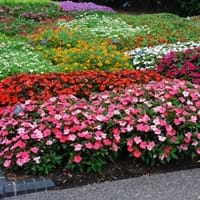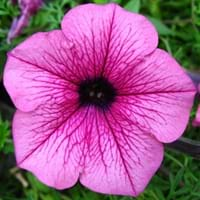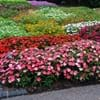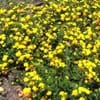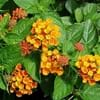Life Span
Annual and Perennial
Annual
Type
Tender Perennial
Flowering Plants, Shrubs
Origin
Hybrid origin
South America
Types
not available
Grandiflora Petunias, Multiflora Petunias, Wave Petunias, Superbell Petunias, Supertunia Petunias
Number of Varieties
Not Available
Habitat
Subtropical climates, Tropical regions
Terrestrial
USDA Hardiness Zone
9-15
9-10
AHS Heat Zone
12 - 1
Not Available
Sunset Zone
H1, H2, 1a, 1b, 2a, 2b, 3a, 3b, 4, 5, 6, 7, 8, 9, 10, 11, 12, 13, 14, 15, 16, 17, 18, 19, 20, 21, 22, 23, 24
not provided
Habit
Clump-Forming
Not Available
Flower Color
White, Red, Orange, Pink, Salmon, Lavender
Blue, Pink, Purple, Red, White, Yellow
Flower Color Modifier
Bicolor
Not Available
Fruit Color
Green
Not Available
Leaf Color in Spring
Yellow, Red, Green, Dark Green, Burgundy, Bronze
Golden Green
Leaf Color in Summer
Yellow, Red, Green, Dark Green, Burgundy, Bronze
Green
Leaf Color in Fall
Yellow, Red, Green, Dark Green, Burgundy, Bronze
Green
Leaf Color in Winter
Light Green
Green
Plant Season
Spring, Summer, Fall, Winter
Summer
Sunlight
Partial Sun, Partial shade
Full Sun, Partial shade
Type of Soil
Loam, Sand
Loamy, Sandy
The pH of Soil
Neutral
Neutral
Soil Drainage
Well drained
Well drained
Bloom Time
Indeterminate
Fall, Spring, Summer
Tolerances
Drought
Pollution
Where to Plant?
Container, Ground, Pot
Container, Ground, Pot
How to Plant?
Stem Planting
Seedlings, Transplanting
Plant Maintenance
Medium
Medium
Watering Requirements
Water when soil is dry
Keep the ground moist but not water-logged, Requires regular watering, Requires watering in the growing season
In Summer
Ample Water
Lots of watering
In Spring
Average Water
Moderate
In Winter
Ample Water
Average Water
Soil Type
Loam, Sand
Loamy, Sandy
Soil Drainage Capacity
Well drained
Well drained
Sun Exposure
Partial Sun, Partial shade
Full Sun, Partial shade
Pruning
Prune prior to new growth
Cut or pinch the stems, Do not prune during shooting season, Remove dead or diseased plant parts, Remove deadheads
Fertilizers
Water soluble fertilizers
All-Purpose Liquid Fertilizer
Pests and Diseases
Aphids, Caterpillars, Downy mildew, Gray mold, Leaf spot, Red blotch, Root knot nematode, Spider mites, Thripes, Whiteflies
Aphids, Bacterial Blight, Caterpillars, Gray mold, Leaf spot, Powdery mildew, Root rot, Spider mites, Thripes, Verticillium Wilt, Viruses
Plant Tolerance
Drought
Drought
Flower Petal Number
Single
Not Available
Fragrant Bark/Stem
No
Yes
Foliage Texture
Medium
Medium
Foliage Sheen
Glossy
Matte
Attracts
Butterflies
Butterflies, Hummingbirds
Allergy
Not Available
Not Available
Aesthetic Uses
Cottage Garden, Ground Cover, Showy Purposes
Beautification, Bouquets, Showy Purposes
Beauty Benefits
No Beauty Benefits
Not Available
Environmental Uses
Indoor Air Purification
Air purification
Medicinal Uses
No Medicinal Use
Not Available
Part of Plant Used
Whole plant
Flowers
Other Uses
Used as Ornamental plant
Showy Purposes
Used As Indoor Plant
Yes
Yes
Used As Outdoor Plant
Yes
Yes
Garden Design
Bedding Plant, Container, Edging, Hanging Basket, Mixed Border, Tropical
Bedding Plant, Container, Edging
Botanical Name
IMPATIENS 'Fisnics Magpink'
Petunia
Common Name
Magic Pink New Guinea Impatiens, New Guinea Impatiens
Petunia
In Hindi
न्यू गिनी Impatiens
Petunia
In German
Neu-Guinea Impatiens
Petunie
In French
Nouvelle-Guinée Impatiens
Pétunia
In Spanish
Nueva Guinea Impatiens
Petunia
In Greek
Νέα Γουινέα Impatiens
πετούνια
In Portuguese
Nova Guiné Impatiens
Petúnia
In Polish
Nowa Gwinea Niecierpek
Petunia
In Latin
Impatiens New Guinea
Petunia
Phylum
Magnoliophyta
Streptophyta
Class
Magnoliopsida
Magnoliopsida
Order
Geraniales
Solanales
Family
Balsaminaceae
Solanaceae
Clade
Angiosperms
Angiosperms, Asterids, Eudicots
Tribe
Not Available
Not Available
Subfamily
Not Available
Petunioideae
Number of Species
Not Available
Season and Care of New Guinea Impatiens and Petunia
Season and care of New Guinea Impatiens and Petunia is important to know. While considering everything about New Guinea Impatiens and Petunia Care, growing season is an essential factor. New Guinea Impatiens season is Spring, Summer, Fall and Winter and Petunia season is Spring, Summer, Fall and Winter. The type of soil for New Guinea Impatiens is Loam, Sand and for Petunia is Loamy, Sandy while the PH of soil for New Guinea Impatiens is Neutral and for Petunia is Neutral.
New Guinea Impatiens and Petunia Physical Information
New Guinea Impatiens and Petunia physical information is very important for comparison. New Guinea Impatiens height is 15.20 cm and width 20.30 cm whereas Petunia height is 5.00 cm and width 2.50 cm. The color specification of New Guinea Impatiens and Petunia are as follows:
New Guinea Impatiens flower color: White, Red, Orange, Pink, Salmon and Lavender
New Guinea Impatiens leaf color: Yellow, Red, Green, Dark Green, Burgundy and Bronze
Petunia flower color: Blue, Pink, Purple, Red, White and Yellow
- Petunia leaf color: Golden Green
Care of New Guinea Impatiens and Petunia
Care of New Guinea Impatiens and Petunia include pruning, fertilizers, watering etc. New Guinea Impatiens pruning is done Prune prior to new growth and Petunia pruning is done Cut or pinch the stems, Do not prune during shooting season, Remove dead or diseased plant parts and Remove deadheads. In summer New Guinea Impatiens needs Ample Water and in winter, it needs Ample Water. Whereas, in summer Petunia needs Lots of watering and in winter, it needs Average Water.
